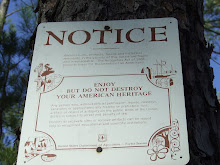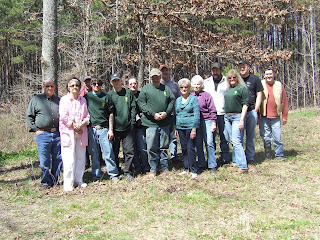fadedfootprints-LRWMA

Friday, April 11, 2014
Wednesday, March 26, 2014
Thursday, December 5, 2013
Monday, April 8, 2013
April 6, 2013 Picnic
Our annual picnic was held at the Benjamin P. and Caroline E. Hulsey Brown house site located on FS road 92B just across from the old road to Ayersville and the Pumping Station/Sellers road.
During the outing volunteers visited the Brown baby graves located just beyond the house site and also the nearby waterfalls. Volunteers that worked 20 or more hours through the months of October and April received the following, an annual pass to several locations of the Chatahoochee-Oconee National Forest and a forest service volunteer T-shirt.
Volunteers were also given information about the surrounding areas from Pearl Wilson. None of the local history of this area would have been known or discovered if it wasn't for all the hard work and dedication by Pearl Wilson. She has 32 plus years under her belt for discovering the local areas and known house sites. Pearl has traveled across many counties in the state of Georgia and also other states volunteering her time with the forest service and Archeologist. Our next tours will begin again in October.
Volunteers in photo: Harlen and Pearl Wilson, Robert and Patricia Kirk, Danny, Deborah, Jeremy and Luke Simmons, Kenneth and Frank Wilbanks, Geraldine Wilson, Joyce Conally, Trent Thomason and Dereck Holland. Not pictured: Shirley Kimbrell, Priscilla Tanner and Dena Brawner.
During the outing volunteers visited the Brown baby graves located just beyond the house site and also the nearby waterfalls. Volunteers that worked 20 or more hours through the months of October and April received the following, an annual pass to several locations of the Chatahoochee-Oconee National Forest and a forest service volunteer T-shirt.
Volunteers were also given information about the surrounding areas from Pearl Wilson. None of the local history of this area would have been known or discovered if it wasn't for all the hard work and dedication by Pearl Wilson. She has 32 plus years under her belt for discovering the local areas and known house sites. Pearl has traveled across many counties in the state of Georgia and also other states volunteering her time with the forest service and Archeologist. Our next tours will begin again in October.
Volunteers in photo: Harlen and Pearl Wilson, Robert and Patricia Kirk, Danny, Deborah, Jeremy and Luke Simmons, Kenneth and Frank Wilbanks, Geraldine Wilson, Joyce Conally, Trent Thomason and Dereck Holland. Not pictured: Shirley Kimbrell, Priscilla Tanner and Dena Brawner.
Sunday, February 3, 2013
Ben Brady house site March 2, 2013
16 volunteers gathered at the check in station on FS road 87 and left for a beautiful drive through FS road 92B and then continued down FS road 192 and visited the Ben Brady house site. A large patch of jonquils were blooming beyond the full standing chimney. The group also located the springhouse with it's rock wall still intact around the spring head. The group also visited the site of old Ballew school located just across from FS road 192 on a hill overlooking the area. The school was a log building and burnt in 1913. Our annual picnic will be held April 6th 10 A.M. at the old B P Brown house site in the Brown Bottom's area on FS road 92B across from the Pumping station/Sellers road. Bring a covered dish, dessert and drink to share. Lunch will start around 12 noon.
Saturday, February 2, 2013
Ayersville School Feb 2, 2013
The Ayersville School, was on a knoll along the west side of the Guard Camp road. It is now covered by a pine forest. A few corner and foundation stones remain, and there is a well depression with a cement block and hand pump located east of the school. Gertrude Brown Collier and her sisters, Willie Mae Brown Powers and Margie Brown Bentley, grew up in Brown's Bottom and could recall walking the road to this "old school house" everyday. She remembers walking it by herself when she was only seven years old. She also had a path that went along the top of the ridge and by an old grave yard. This was known as the "Burnt Meeting Place". In a 1922 Educational Survey of Stephens County, The Ayersville school is described as: " Area two acres, unimproved; no play appliances; supervised play; no gardens; no toilet. Value $800.00; one room; properly lighted; well kept; no cloak rooms; heated by stove; good ventilation; unpainted inside. Double patent desks; no teacher's desk; 20 in. Hyloplate blackboard; no charts; no globes; no pictures; no reference dictionary; a covered water cooler. One teacher; 5 grades; 42 pupils; no programs posted; no clubs; seven months school year (Duggan and Bolton 1922:27)."
Mrs. Collier wrote from memory about the school in the Ayersville community: "We started to school after the fall harvest until the spring planting. It was a joy to get away from work and play and be with other children. We could dress in underwear (union suits), with legs and long sleeves, long stockings, high top shoes, and a sweater and long coats. The weather was always cold in winter with lots of snow, rain, and sleet. We walked about three miles to school. We had a big pot-bellied stove which we had to fire up when we got to school. The wood was green and wet. The boys hunted pine knots in the woods to get the fire strated. It never got warm until we got ready to go home. We carried our lunch of biscuits with sausage, ham, jelly, or honey to school in a tin bucket. Sometimes we would wrap it up in a sheet from the Atlanta Constitution (which we got in the mail every day). The first grade through the seventh was taught in one large room. I was small but learned a lot by listening to what the higher grades were being taught. A big bell set on top of the building and it would ring when recess was up. We got water from a spring that had a bucket and dipper. We all drank from that. Later a well and a pump was put in. We pumped the water by hand. Our bathroom was the woods, the girls went in one direction, the boys in another direction. (We never met in the middle).
Gertrude attended grades 1-7, then repeated seventh grade two or three times. Then the family moved into Toccoa, in order for the two youngest girls to finish high school. One graduated in 1933.
Mary Lee Steele went to Ayersville School for about two years. Mary remembered Gertrude Collier taught school at Ayersville while she was there. Paul Crump was a teacher there also.
Mrs. Collier wrote from memory about the school in the Ayersville community: "We started to school after the fall harvest until the spring planting. It was a joy to get away from work and play and be with other children. We could dress in underwear (union suits), with legs and long sleeves, long stockings, high top shoes, and a sweater and long coats. The weather was always cold in winter with lots of snow, rain, and sleet. We walked about three miles to school. We had a big pot-bellied stove which we had to fire up when we got to school. The wood was green and wet. The boys hunted pine knots in the woods to get the fire strated. It never got warm until we got ready to go home. We carried our lunch of biscuits with sausage, ham, jelly, or honey to school in a tin bucket. Sometimes we would wrap it up in a sheet from the Atlanta Constitution (which we got in the mail every day). The first grade through the seventh was taught in one large room. I was small but learned a lot by listening to what the higher grades were being taught. A big bell set on top of the building and it would ring when recess was up. We got water from a spring that had a bucket and dipper. We all drank from that. Later a well and a pump was put in. We pumped the water by hand. Our bathroom was the woods, the girls went in one direction, the boys in another direction. (We never met in the middle).
Gertrude attended grades 1-7, then repeated seventh grade two or three times. Then the family moved into Toccoa, in order for the two youngest girls to finish high school. One graduated in 1933.
Mary Lee Steele went to Ayersville School for about two years. Mary remembered Gertrude Collier taught school at Ayersville while she was there. Paul Crump was a teacher there also.
Saturday, January 12, 2013
Simmons-Meeler Cemetery Jan 5, 2013
The Faded Footprints of Families and Friends of the Lake Russell Wildlife Management Area group cleaned and placed flowers at the Simmons-Meeler cemetery during its most recent outing. The group also placed flowers on the graves of Thomas Thomason and wife Sarah Farmer Thomason at the Thomason cemetery. The group toured the Old Leatherwood community just off Cannon road and (FS) Thomason road in Toccoa. Known homesteads and families in the area were Simmons, Meeler, Thomason, Ward, Kelly, Roberts, Smith, Payne, Brady, Aderholt, Whitfield, Addison, Farmer, Hooper, Hendricks and possibly the Fricks family. Also known sites Cannon school, Leatherwood store and post office, Thomason store and several partial standing chimneys remain on the old homesteads. Graves of James Willis Simmons born: 1816 (SC) died: sometime after 1870 in Habersham now Stephens county; Georgia and Rebecca 'Becky' Meeler born: about 1855 died: 1881, are nearby. Known burials inthe Simmons-Meeler cemetery are Matthew Meeler born: 1829 died 1898, the son of William and Sarah Cynthia Smith Meeler. Matthew served in the Army of Confederate States of America, Co. D, 43rd Georgia Regiment, Infantry Army of Tennessee, Banks County Georgia, Middle River Volunteers. He married Arletta 'Lettie' Bug Smith. She was born in 1838, the daughter of Sam and Alsie Maddocks/Maddox Smith. Matthew was a possible nephew to Lettie Smith.
Subscribe to:
Posts (Atom)

- Faded Footprints
- Faded Footprints of Families & Friends of The LRWMA. It was home to Six Communities: Ayersville, Currahee, Leatherwood, Mountain Grove, Nancy Town, and New Switzerland.







